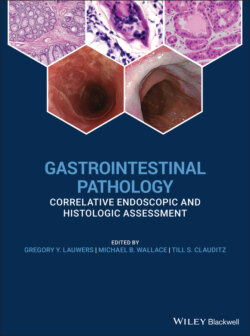Читать книгу Gastrointestinal Pathology - Группа авторов - Страница 49
Cytomegalovirus (CMV)
ОглавлениеCulture is not used routinely, and does not distinguish the simple presence of CMV from active infection; however, culture may be useful for identifying drug resistance.
Ulceration and granulation tissue formation with associated acute inflammation is common. In contrast to HSV esophagitis, CMV rarely infects the squamous epithelium, and preferentially involves endothelial cells, stromal cells, and glandular epithelium. Therefore, biopsies of the ulcer bed should preferentially be performed when CMV esophagitis is suspected (Figure 2.7). CMV cytopathic effect is characterized by nuclear enlargement with classic “owl eye” large intranuclear inclusions, and granular, eosinophilic cytoplasmic inclusions (Figure 2.8a). Smaller, atypical intranuclear inclusions may be present and are more subtle, simulating activated fibroblasts. These infected cells are best identified by immunohistochemical staining (Figure 2.8b). CMV may coexist with HSV and Candida infection in some cases.
Figure 2.7 Erosive esophagitis with prominent granulation and atypical cellular elements.
